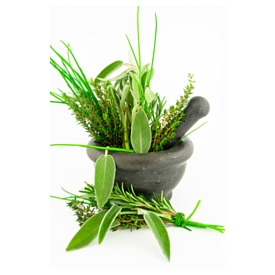
When you cook with herbs, food tastes better and smells fabulous. Plus they add a nutrition boost to your meal. Herbs contain beneficial phytonutrients and antioxidants to keep the body strong. Using herbs instead of salt to season foods decreases the risk of heart disease and high blood pressure later in life so kids grow up to be stronger and healthier. A pinch or a dash is all you need to liven up any dish.
Introducing herbs to kids at an early age help to develop their sense of taste and will make food more interesting. Choose fresh or dried herbs depending on what is available in your area. If you would like to try growing your own, herbs grow well in indoor containers or outdoor gardens. They are quite easy-to-grow and are fun to see on your window sill.
The use of different herbs and spices is cultural and varies by cuisine. Here is a guide to herbs and spices based on some cuisines:
French Cooking:
• Fennel – Fennel’s refreshing licorice flavor enhances poultry and vegetable dishes. Fennel is also a great source of Vitamin C. Use dry fennel seeds in soups or stews or roast the bulbs and serve as a vegetable.
• Lavender – This herb is commonly found in perfume or aromatherapy, but some varieties are edible. Use fresh or dried lavender flowers in baked goods and as a seasoning for vegetables.
• Marjoram – Marjoram tastes a bit like oregano with a delicate citrus twist. It is a great all-around herb and can be used to season meats, eggs and vegetables.
• Mint – Fresh mint’s refreshing flavor makes is the perfect ingredient for a great summer meal. It is served with fruit (in a salad or punch) or paired with a vegetable.
• Rosemary – Rosemary’s contains anti-oxidants and a full flavor, which makes it both a tasty and healthy addition to roasted potatoes and grilled or roasted meats (especially lamb).
• Sage – Sage is best known as the seasoning to use in your Thanksgiving stuffing, but don’t save it for just that purpose. Use fresh or dried sage on pork, chicken, rice and vegetable dishes.
• Tarragon – Adding a small amount of fresh or dried Tarragon to vinegars and oils is a great way to add flavor to meat, seafood and vegetable dishes.
• Thyme – Thyme is a culinary favorite for many chefs. Use thyme to season soups, salads, meats and vegetables. It brings a sweet, lemony flavor to food.
Recipe: Herbs de Provence
Herbs de Provence is a robust mixture of dried herbs made popular in the southeastern region of France. It is often used to flavor grilled meats, fish, eggs and vegetables. It is added before or during cooking. There are many variations to this herb mixture but most recipes use rosemary, savory, marjoram, and thyme. Lavender is a new addition to the mixture and adds wonderful aroma.
In a small mixing bowl, combine:
• 5 Tbsp. Dried thyme
• 3 Tbsp. Dried savory
• 2 Tbsp. Dried marjoram or oregano
• 5 Tbsp. Dried rosemary
• 1 Tbsp. Dried lavender flowers (optional)
Store in an air-tight container in a dark place. Use as a seasoning for grilled meats, fish, eggs and vegetables. For best results, add before or during cooking.
Irish Cooking:
- Parsley – Add chopped parsley to a white sauce to create a traditional Irish Parsley Sauce. This sauce is used to season ham and cabbage dishes.
- Sage – The Irish use sage to season poultry prior to cooking. Add sage to simmering onions to create a topping for chicken, duck and turkey.
- Rosemary – Roast potatoes with dried rosemary for a healthy Irish side dish that is sure to please.
- Thyme – Irish cooks use thyme to season soups and poultry. Try adding thyme to roasted chicken for a flavorful protein source.
- Bay leaves – Bay leaves add a bit more comfort to some of the best Irish comfort foods such as beef and lamb stews. A pot of soup will also taste better when you add a bay leaf while simmering.
- Irish bakers like to use nutmeg, cinnamon, cloves and vanilla to create delicious breads and cakes.
Italian Cooking:
- Basil – Basil is the staple herb in Italian cooking. It is used to create a pesto and brings a sweet aroma and taste to red sauces, pizza and fish dishes.
- Parsley (flat-leafed variety) – The flat leafed variety of parsley is also known as Italian Parsley. Sautee fresh chopped Italian Parsley with olive oil and garlic to create a base for Italian soups, sauces and meat seasonings.
- Oregano – Dried oregano stores well and is great to have around to perk up a frozen pizza. Your family will taste the difference!
- Thyme – When sautéing vegetables for Italian dishes such as peppers and eggplant, add thyme early in the cooking process so the oils have time to release and the flavor reaches its peak.
- Marjoram – Marjoram is a good choice for enhancing the flavor of pasta sauce and Italian seafood dishes.
- Lemons – Lemons grow throughout Italy and are also used to enhance many Italian dishes including seafood, pasta and desserts.
Mexican Cooking:
- Chile – The most well known seasoning in Mexican cooking is the chile pepper. Hot or mild, dried or fresh, chiles are the spice of choice for many traditional dishes.
- Cilantro – Cilantro is a popular herb in many Mexican dishes. Cilantro has a distinctive citrus-like taste that brings freshness to meals.
- Cumin – Cumin is a widely used spice in chili and stew. It has a wonderful scent but can taste bitter so quantity is important to pay attention to when flavoring dishes.
- Mexican Oregano – Both Mexican and Greek Oregano come from the mint family. The Mexican variety has a stronger flavor and is less bitter than the Greek variety.
- Garlic – Pungent and very flavorful, garlic is an essential ingredient in cuisines around the world. There are many varieties of fresh garlic available including white skinned, elephant garlic, and purple garlic. Dried, powdered garlic is also easy to find in the spice section of the grocery store.
- Mexican Chocolate – Mexican chocolate contains cinnamon, almonds and vanilla and is used in many Mexican specialty dishes including mole sauce and chili recipes. If you can’t find Mexican chocolate in your supermarket, you can make it by combining 1-ounce of semisweet chocolate, ½ teaspoon ground cinnamon and 1 drop almond extract.
Indian Cooking:
- Curry Powder (Yellow) – Curry powder is made using a combination of spices including coriander, turmeric, cumin and red pepper. A variety of other spices can also be used depending on the recipe. Tumeric is the ingredient that gives yellow curry its color. Yellow curry is milder and sweeter than other curry powders.
- Garam Masala – Garam Masala is also a blend of spices that typically includes peppercorns, cloves, cinnamon, and cardamom. It is very aromatic and works well as an all-purpose seasoning in Indian dishes.
- Cumin – Cumin adds a unique flavor to Indian curries. Cumin has a wonderful scent but can taste a bit bitter so it is important to pay attention to the quantity used when flavoring dishes.
- Cinnamon – Cinnamon has been used to flavor food for centuries. The cinnamon we use in America is usually Indonesian cassia, which is very close the true cinnamon but with a slightly lighter flavor. Cinnamon is used to flavor everything from breads and desserts to meat and vegetable dishes.
- Nutmeg – Nutmeg is sweet and aromatic spice much like cinnamon. It is often used ground or grated in pork, squash, sauces and baked goods.



